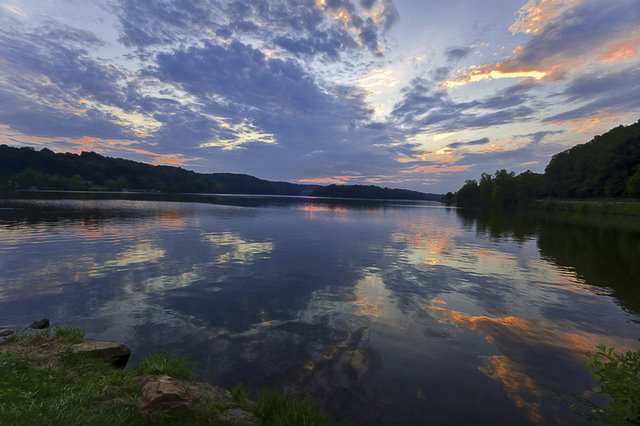Lake Logan State Park
- Hocking Hills,Ohio
One of the best fishing
lakes in Ohio awaits sportsmen in Hocking
County at Lake Logan State Park. The lake
sports northern pike, bass, bluegill,
crappie, catfish and shuteye. Lake Logan Isa
day-use park that provides scenic picnic
areas and secluded walking paths to enjoy
the wooded beauty of Ohio's hill country.

Nature of the Area
Much time has passed since the region
surrounding Lake Logan was first uplifted
from the ancient sea that once covered most
of Ohio. This unglaciated plateau in the
southeastern part of testate is Ohio's
oldest landscape as the glaciers never
invaded the region. Lake Logan State Park
lies in the Hocking Valley, formed by the
Hocking River. The Hocking was a major
outlet for glacial melt waters. These waters
deposited large amounts of outwash material,
primarily sand and gravel, which strongly
affected the type of biological communities
present today.
The forest surrounding Lake Logan is for the
most part an oak-hickory association. White
and black oak, tulip tree, shagbark and
pignut hickory are the most dominant
species. The forest floor is dotted with a
variety of wildflowers such as fire pink,
wintergreen, bluets and spring beauties.
Ground cover plants include greenbriar,
blueberry and numerous ferns and fungi.
Lake Logan is home to the raccoon, opossum,
skunk, red-backed salamander, gray squirrel,
box turtle, white-tailed deer and wild
turkey. Many birds frequent the area such as
the turkey vulture, red-tailed hawk, barn
owl, pileated woodpecker, Carolina
chickadee, tufted titmouse, wood thrush and
scarlet tanager. Various species of
waterfowl can be viewed during migration.
History of the Area
Lake Logan is located in Hocking County in
southeastern Ohio. This territory once
belonged to the Wyandot Indians, who had a
large village known as Old town on the
Hocking River, one mile above the city of
Logan. Logan was established by Thomas
Worthington in 1816 and named for the Mingo
Chief, James John Logan, who was well known
at first for his friendship with the whites
and later for his bitter animosity toward
them following the murder of his entire
family by a frontier trapper named
Greathouse.
The Hocking River provided sufficient water
power for the purpose of operating grist and
sawmills particularly at the falls above
Logan. The town of Logan was slow to
progress until the opening of the Hocking
Canal, a branch of the Ohio-Erie Canal,
in1838. Several industries prospered due to
the rich mineral resources of the Hocking
Valley.
The discovery of immense quantities of coal
led to the flourishing mining industry.
Towns appeared and vanished as quickly as
mines opened and closed.
It was soon found that iron ore could be
extracted from the sandstone bedrock of the
area. At its height during the Civil War,
Ohio was the leading producer of iron for
implements and weapons. No less than
forty-six furnaces were firing in Ohio's
six-county Hanging Rock Iron Region.
The clay soils of the Hocking Valley helped
Ohio become a leader in clay products. The
firebrick industry of the valley
manufactured such products as clay tile,
building and paving bricks and clay sewer
pipe. Evidence of the industry can be seen
in the many brick houses and abandoned kilns
of the area. Clay is still an important
industry in the region.
Lake Logan was developed in 1955 for
recreational purposes. The area was
administered by the ODNR Division of
Wildlife until1964, when jurisdiction was
transferred to the Division of Parks and
Recreation. Originally known as Hocking
Lake, it was re-named Lake Logan to reflect
the Indian heritage of the area and to avoid
confusion with nearby Hocking Hills State
Park and Forest.
|
|